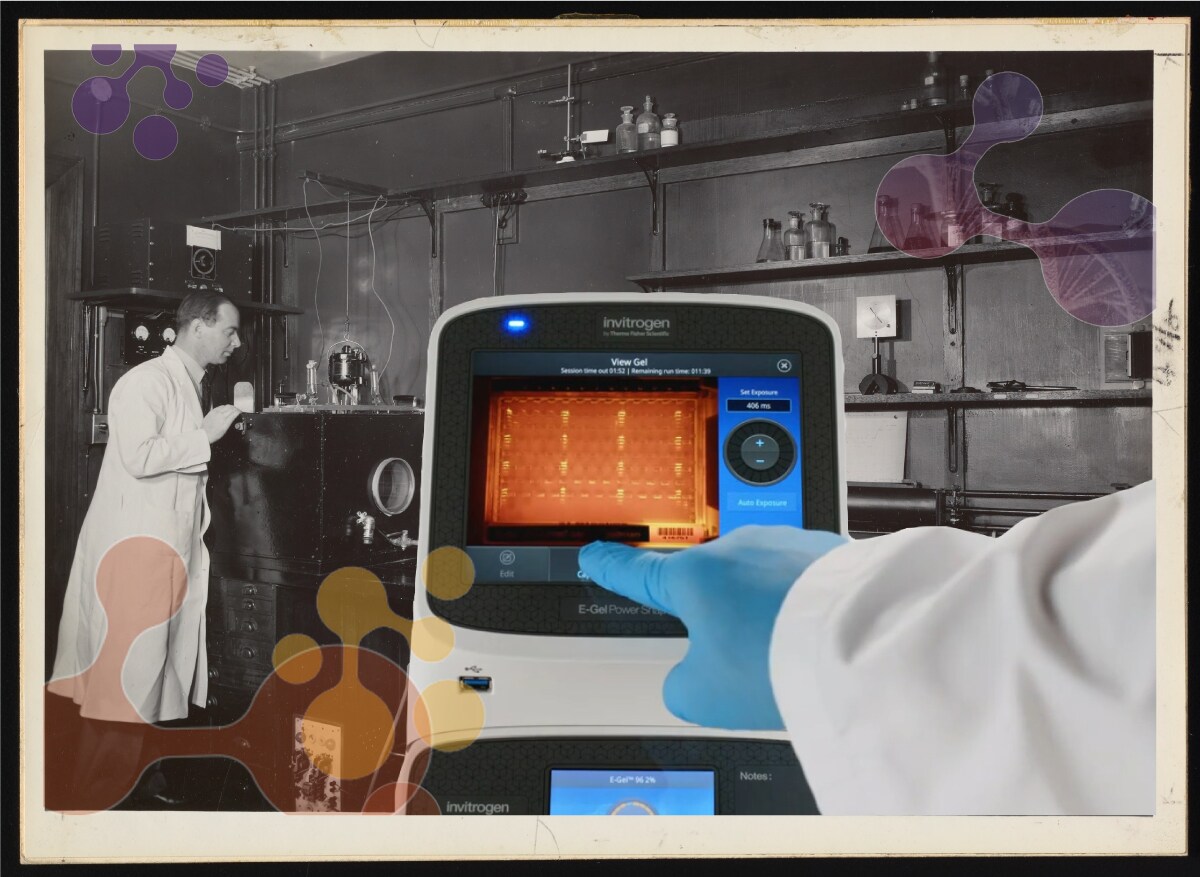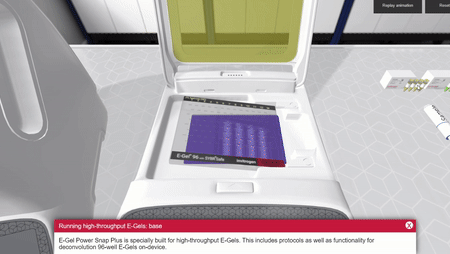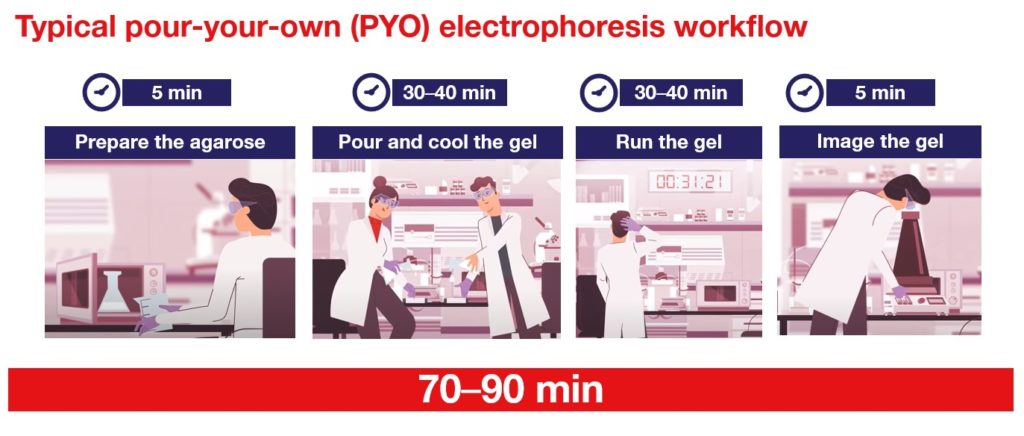
How 100 years of electrophoresis innovation has finally landed in the cloud – from the first room-sized apparatus to today’s next-gen, toaster-sized all-in-one device
This year marks the 70th anniversary of the discovery of DNA, which came just one year before the invention of starch gel electrophoresis.1 In less than a lifespan, molecular biology has ascended from nascent field to modern powerhouse–helping to drive innovation in everything from cancer research to criminal justice to ecosystem health.
To follow the story of the evolution of nucleic acid electrophoresis through nearly a century is to trace a parallel strand all the way down the helix, from the formation of molecular biology to the rise of contemporary, instrument-driven lab analysis.
It starts with a complex, industrial instrument that once filled an entire room, and ends with a sleek, toaster-sized machine in the InvitrogenTM E-GelTM Power Snap Plus electrophoresis system —an all-in-one smart device with features advanced enough to handle high-throughput research, yet housed in a design simple and safe enough that even school children could use it.
The first electrophoresis chamber and the Age of Instrumentation
The story of the first electrophoresis chamber begins not with a breakthrough, but with a failure.
Swedish chemist Arne Tiselius had successfully defended his 1930 graduate thesis exploring a technique for separating proteins by current, but the lack of a clear resolution plagued him – Tiselius wrote that he felt “an almost physical suffering” when looking at some of his early electrophoresis photographs, knowing that he had fallen just short of perfecting a method.2
Frustrated, he decided to abandon organic chemistry entirely and move on to something fresh with the study of the volcanic mineral zeolite. But his dissertation continued to weigh on his mind as friends and colleagues discussed their urgent need for a reliable method of separating proteins. They convinced him to take another look.3
Using a U-tube hand-ground from quartz, Tiselius finally built the first successful electrophoresis chamber in 1938. The research impact of his setup was immediately apparent. As a test, he analyzed horse blood serum and was surprised to discover that in addition to the known protein albumin, there were at least 3 other previously unknown types of protein in the sample – the globulins he named alpha, beta, and gamma.4
Although a boon for scientists of the time, Tiselius’ new electrophoresis apparatus was in many ways incredibly impractical.
First, for its size – it stood 20 feet long and 5 feet high, taking up so much bench space that it ideally required its own separate room for the equipment, accessories, and photographic materials.5 It was also extremely expensive. In the 1930’s, the cost to build and maintain a Tiselius electrophoresis apparatus was around $11,000, roughly equivalent to a quarter of a million dollars today.6,7 A historian in 1988 compared it to the cost of operating a contemporary cyclotron.8
For this reason, only the most high-profile, well-funded labs in the world had a Tiselius apparatus. In 1939, there were only 14 in the entire United States.9
This was a course-shifting moment for the life sciences, the start of a transformation in how biology was done. Scientists in this era began looking towards a future of discoveries facilitated by sophisticated instrumentation and experiments performed on a scale that had never been possible before.10 Along with the ultracentrifuge, which had been invented in 1925 by Tiselius’ mentor and fellow Nobel laureate The Svedberg, the Tiselius apparatus was one of the first electrical biology instruments.
The electrophoresis chamber hit the general market as an off-the-shelf commercial product in the 1940’s, and it was off to the races towards an exciting new era of molecular biology.

Swedish biochemist Arne Tiselius (1902-1971) demonstrating the use of an electrophoresis apparatus at the University of Uppsala during a 1939 meeting of the American Chemical Society. (Public domain; courtesy of Science History Institute)
Everything gels together
In 1954, hot on the trail of the double helix discovered just a year before, a postdoc named Oliver Smithies was trying to get the hang of using his lab’s state-of-the-art Tiselius apparatus in his search for an insulin precursor. He was not having great luck. His efforts yielded incomplete separations and on top of that, each analysis required unreasonably large protein samples.
Smithies decided to try out a newer method of electrophoresis using buffer-soaked filter papers. Though it required only small samples, for certain proteins like insulin it often led to smeared bands and frustratingly unclear results. Someone had already developed a workaround using a moist bed of potato starch grains, but it meant running proteins on 40 cut segments of the grain to form a pattern.
“Impossible for me!” wrote Smithies in recollection years later. “I did not even have someone to wash my lab glassware!”11
Not ready to give up, Smithies remembered his mother’s laundry days and “noticing that the hot gooey liquid she made to starch the collars of my father’s shirts set into a gel when left standing.” What if he could create something similar? Perhaps the proteins would migrate through potato starch gel without trailing?
And they did. Just like that, gel electrophoresis was invented.
Smithies’ win that day was much bigger than protein analysis. In the post-double-helix era, his invention would also catalyze a golden age of rapid development in the study and separation of nucleic acids. Horizontal tanks, ethidium bromide gels, and pulsed-field electrophoresis continued to expand the capabilities of electrophoresis for DNA and RNA analysis from the 1970s to 90s.12
Ditching the accessories: the era of all-in-one DNA electrophoresis
When the Invitrogen™ E-Gel™ Power Snap Electrophoresis System came along in 2017 after many years of electrophoresis technology stagnation, it brought features that no one had seen in a gel setup before.
“It was kind of a breakthrough instrument when it was released. Nothing remotely like it was on the market,” said Paulius Palaima, a product manager at Thermo Fisher Scientific.
The original E-Gel Power Snap system combines dry, precast gel DNA electrophoresis and digital gel imaging into one standalone, integrated system that takes up very little space on the benchtop.
“It’s very easy to use. We put a lot of effort into making it extremely intuitive. It has an integrated camera, which just mounts on top so that you can view your gel progress at any time during the run,” said Palaima.
Its newest upgrade, the E-Gel™ Power Snap Plus electrophoresis system, takes the best of the E-Gel Power Snap base and adds a few additional features: a high-definition camera, cloud network connection, improved ergonomics, direct printing, and high throughput compatibility.
The refreshed system also meets today’s bustling biotech industry with a new opportunity to scale. It is the first integrated electrophoresis platform to accommodate high-throughput workflows, with plates of up to 96 wells. The same way that Tiselius’ apparatus opened new doors for biology with a standard instrument, high-throughput systems like the E-Gel Power Snap Plus are pushing the boundaries for research productivity even further.
In one toaster-sized, affordable, integrated package, the E-Gel Power Snap Plus checks a lot of boxes.
It addresses those sticky challenges inherent to lab work and electrophoresis that, despite nearly a century of rapid innovation since Tiselius’ time, have persisted. Perennial issues like tight budgets, limited benchtop space, and cumbersome workflows involving a roomful of accessories.

> Take an interactive, 3D tour of the E-Gel Power Snap Plus
To explore the 3D tour, click the link and select the gear icon at the bottom-right corner of the screen for information about how to get started. Prefer a video? Watch here.
Most of all, the system tackles a particularly enduring dilemma – too much to do, not enough time to do it.
“The standard electrophoresis procedure hasn’t really changed in 50 years,” said Palaima. “It’s a game of wasting time. It requires a lot of hands-on time with long waits between steps.”
Sometimes it can feel like there’s no way around the time cost – the task simply needs to be done to move forward.
“Electrophoresis is one of those techniques in molecular biology that is behind-the-scenes in every key step. It’s not flashy and researchers never talk about it, but you know that you have to do it. Technique is like that. You need quality control,” said Palaima.
The E-Gel Power Snap Plus system focuses on making the essential process of DNA and RNA analysis as safe, simple, and effortlessly routine as it should be some 70 years after Smithies’ first electrophoresis gel run. It keeps quality control at the periphery so that more complex work can take the center stage.
“Sometimes you have to run three or four gels a day, and if you’re making the gels yourself, that’s six to seven hours of your life gone,” said Palaima. “It’s about having the tools to spend time on things that really matter, the serious techniques. That’s what these electrophoresis systems and precast gels enable. You can run up to five E-Gels in the same time as a single pour-your-own experiment.”
The traditional “pour-your-own” gel electrophoresis workflow typically takes between 70-90 minutes per gel. The E-Gel Power Snap or Power Snap Plus systems can do it in 14-40 minutes.


The traditional “pour-your-own” gel electrophoresis workflow typically takes between 70-90 minutes per gel. The E-Gel Power Snap or Power Snap Plus systems can do it in 14-40 minutes.
The integrated approach is also a surprisingly affordable solution. Where a traditional electrophoresis setup can easily run over $15,000 for all the necessary parts, the Power Snap Plus typically falls in the $5,000 range for an all-in-one device.
“Customers were excited at that price point because oftentimes, if an instrument exceeds $10,000, researchers must get administrative approval for the purchase,” said Stacie Jackson, a global market development manager at Thermo Fisher. “We had a customer that said, ‘I can just go out and buy this, without having to go through that approval process, and get it into my lab right away.’”
Along with addressing challenges that have plagued labs for decades, the E-Gel Power Snap Plus delivers solutions to uniquely modern problems.
“Our homes and cars have become ‘smart,’” said Angela Asuncion, a senior marketing manager at Thermo Fisher. “You can change the temperature of your home, open your garage door, and so many other things remotely. Labs are behind the curve, but we are working on that by introducing cloud-enabled instruments.”
The E-Gel Power Snap Plus takes customer feedback from its E-Gel Power Snap predecessor and gathers it all together into a “smart” semi-modular package with direct printing, wireless connection, cloud network connectivity, and a sharp 13-megapixel camera for high-definition images.
Researchers can also leave toxic chemicals to the past with safer, more sustainable precast E-Gel and stain options like the SYBR Safe DNA gel stain, which eliminates the need for ethidium bromide and other harmful dyes.
The E-Gel Power Snap Plus setup creates a workflow that is so safe and self-contained that it could help educators bring the concept of electrophoresis to their students.
“I was in a conference and everyone kind of wanted to touch it and play with the instrument,” said Palaima. “It was very interesting to see because even people from the education field were very interested in these instruments, just because of the convenience of not needing anything aside from a gel.”
“These instruments could eventually make electrophoresis something that you never need to worry about, seamless and care-free.”
Learn more about the E-Gel Power Snap Plus at thermofisher.com/powersnapplus»
Want to read more stories like this? Subscribe to Connect to Science, your portal for life science news.
References
- Dambeck, Susanne. “Oliver Smithies: How Potatoes Revolutionised Electrophoresis.” Lindau Nobel Laureate Meetings, April 23, 2016. https://www.lindau-nobel.org/oliver-smithies-how-potatoes-revolutionised-electrophoresis/.
- Tiselius, Arne. “Reflections from Both Sides of the Counter.” Annual Review of Biochemistry 37, no. 1 (1968): 1–23. https://doi.org/10.1146/annurev.bi.37.070168.000245.
- Tiselius, “Reflections from Both Sides of the Counter.”
- Tiselius, Arne. “Electrophoretic Analysis and the Constitution of Native Fluids: Harvey Lecture, October 19, 1939.” Bulletin of the New York Academy of Medicine 16, no. 12 (1940): 751–80.
- Kay, Lily E. “Laboratory Technology and Biological Knowledge: The Tiselius Electrophoresis Apparatus, 1930-1945.” History and Philosophy of the Life Sciences 10, no. 1 (1988): 51–72.
- Kay, “Laboratory Technology and Biological Knowledge: The Tiselius Electrophoresis Apparatus, 1930-1945.”
- “CPI Inflation Calculator.” U.S. Bureau of Labor Statistics. U.S. Bureau of Labor Statistics. Accessed December 6, 2022. https://www.bls.gov/data/inflation_calculator.htm.
- Kay, “Laboratory Technology and Biological Knowledge: The Tiselius Electrophoresis Apparatus, 1930-1945.”
- Stapleton, Darwin H. “Oswald T. Avery and the Technological Basis for the Discovery of DNA at the Rockefeller Institute for Medical Research.” Icon 18 (2012): 35–44.
- Stapleton, “Oswald T. Avery and the Technological Basis for the Discovery of DNA at the Rockefeller Institute for Medical Research.”
- Smithies, Oliver. “How It All Began: A Personal History of Gel Electrophoresis.” Methods in Molecular Biology, 2012, 1–21. https://doi.org/10.1007/978-1-61779-821-4_1.
- “Nucleic Acid Gel Electrophoresis – A Brief Overview and History.” Thermo Fisher Scientific . Accessed January 9, 2023. https://www.thermofisher.com/us/en/home/life-science/cloning/cloning-learning-center/invitrogen-school-of-molecular-biology/na-electrophoresis-education/na-separation-overview.html.
For Research Use Only. Not for use in diagnostic procedures.
Leave a Reply